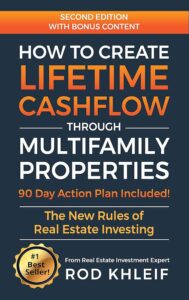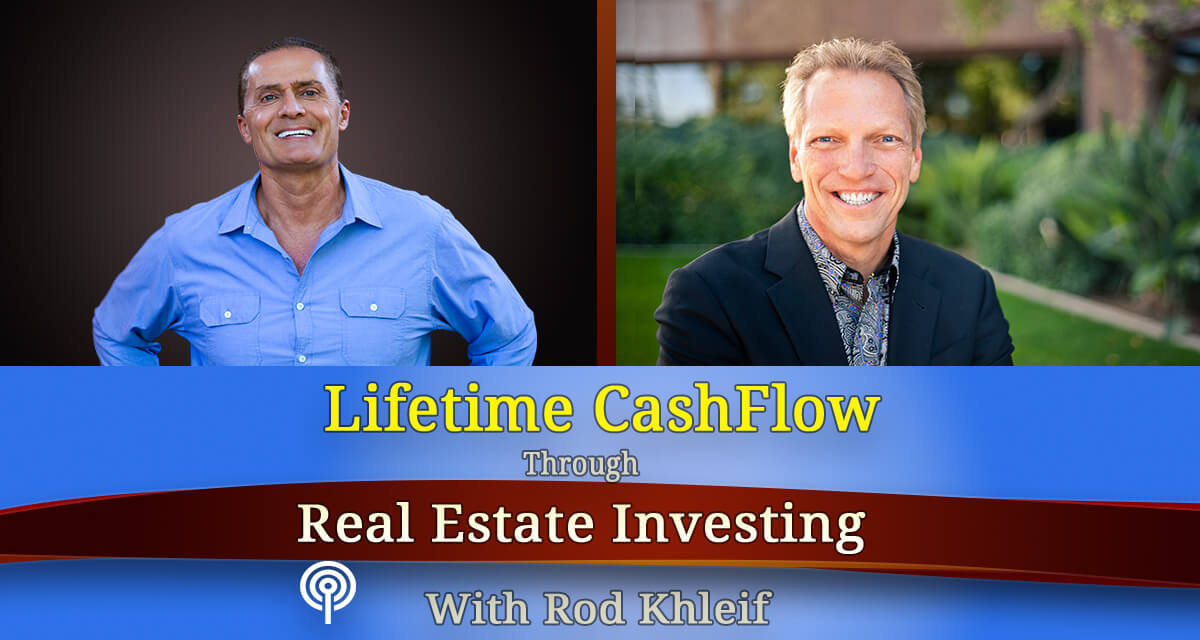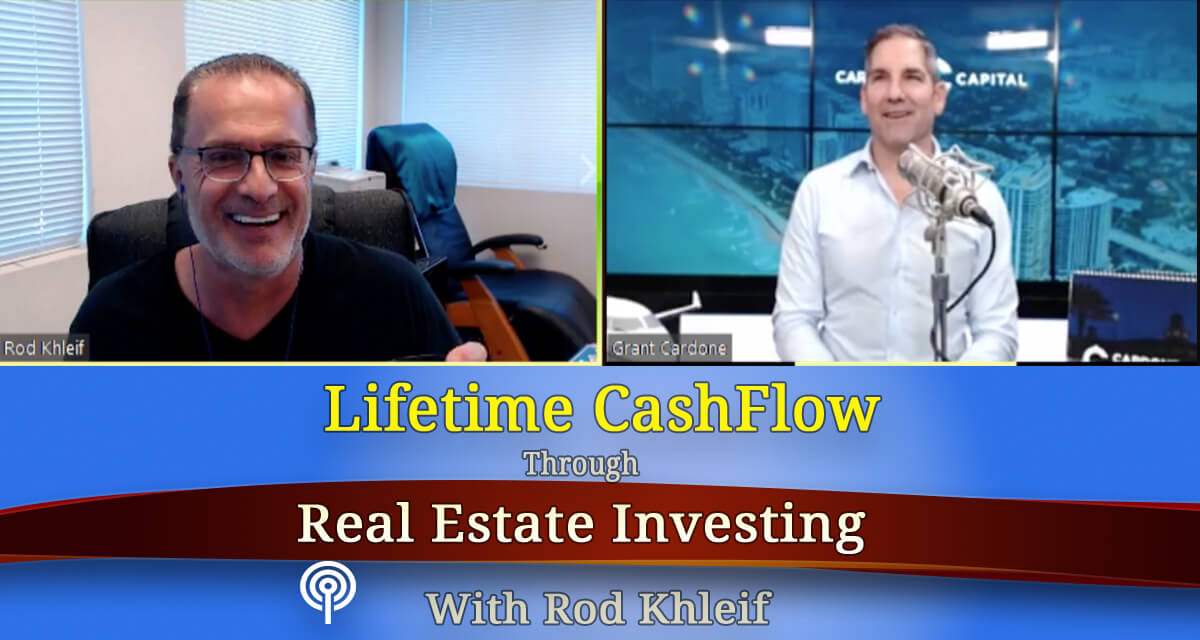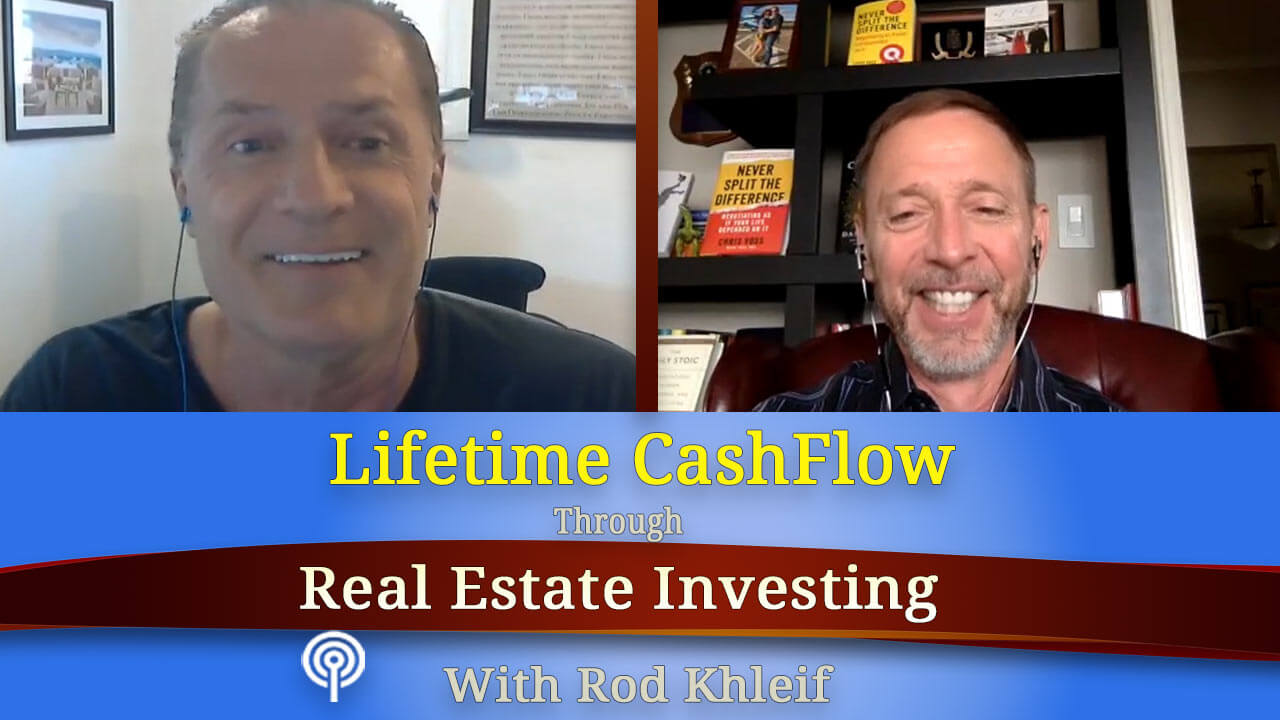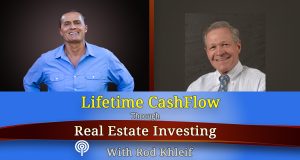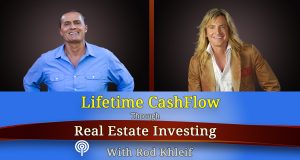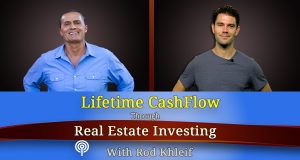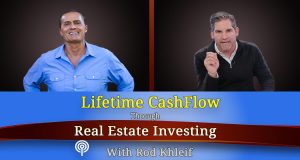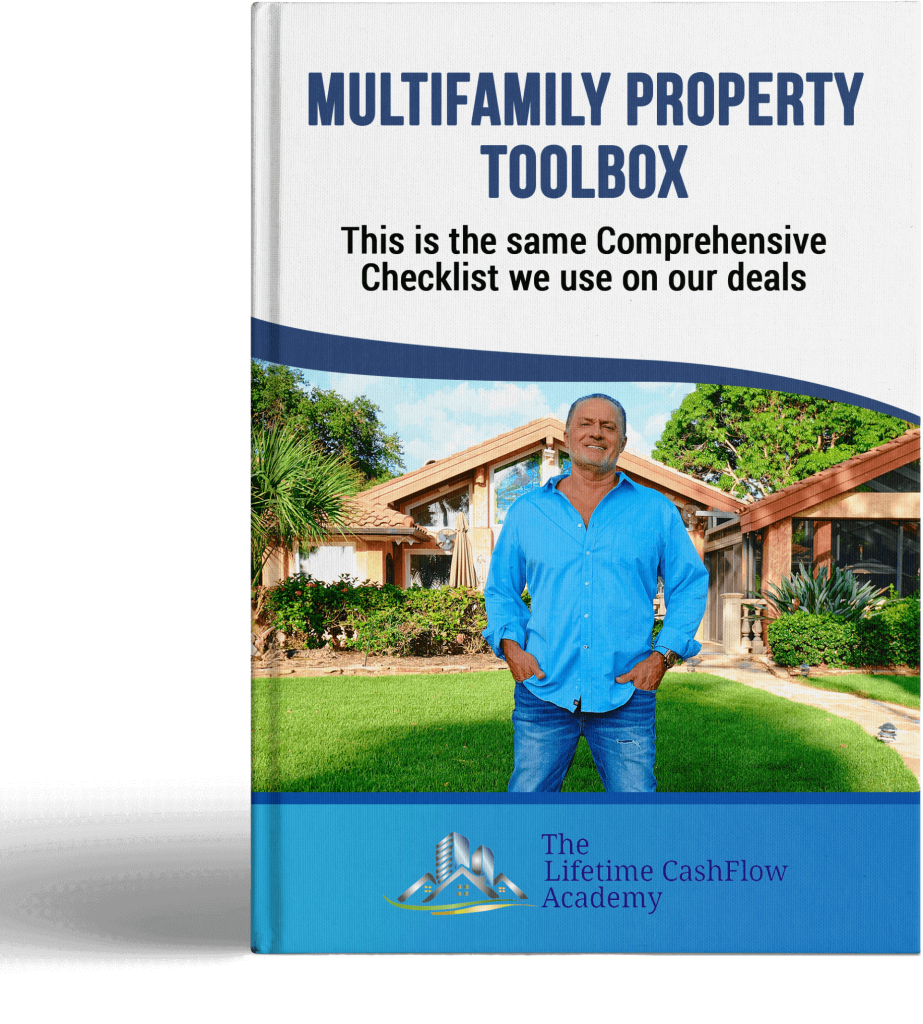Ep #113 – Jered Sturm – Currently owns and operates a $3.7 million portfolio including a 42 unit multifamily property.
- What is the Power of compounding?
- Consistency & Follow Up.
- How to build your Rick muscle.
- How to be consistent.
- How to build credibility
- When to use a sponsor
- What to bill back to tenants
- What is R.U.B.S.?
- How to Build/keep relationships
- How to buy your first property
- Learn more about Jared at http://snscapitalgroup.com/
- Connect with me on Facebook at: Rod Khleif
- Text ROD to 41411 or visit RodKhleif.com for a FREE copy of my book, “How to Create Lifetime Cash Flow Through Multifamily Properties.”
Do you want to learn more about Multifamily Real Estate Investing? Work with Rod in the Lifetime CashFlow Academy’s Multifamily Course & Coaching Program
Full Transcript Below:
Ep 113 – Jered Sturm – Currently owns and operates a $3.7 million portfolio including a 42 unit…
Welcome. This is the Lifetime Cash Flow Through Real Estate Investing Podcast. This is where you’ll learn strategies to help you achieve lifetime financial freedom through real estate investment. Your host, Rod Khleif, has owned over 2,000 homes and apartments. And he brings experts in all aspects of real estate investment and management on to the show. Now, here’s your host, Rod Khleif.
Rod Khleif: I wanna ask a favor of you guys. If any of you listening have purchased a multi-family property as a result of things you’ve learned or maybe been inspired by in this podcast, please email me at rod@rodkhleif.com and tell me about it. It’s r-o-d-@-r-o-d-k-h-l-e-i-f-.com.
Tell me about your deals. I can’t tell you how much pleasure I get when I get those emails, and have conversations with you guys, about the fact that you took action, and you’ve got your first property or your second property. So please, give me that gift when you do take action and buy a property. Again, it’s rod@rodkhleif.com.
I also wanna mention that we have some partnership opportunities coming up. We’re actively buying small apartment buildings and even mobile home parks right now, and I’m always looking for people to partner with me. So if you have an interest in potentially partnering together on a deal, shoot me an email. That email would be partner@lifetimecashflowacademy.com. I know that’s a lot, partner@lifetimecashflowacademy.com.
We’re kicking butt, we’ve got a lot of activity happening. If you have an interest in potentially partnering with me on some deals, and looking over my shoulder, as we do them together, send me an email. Now, it is an auto-responder email, so almost immediately you’ll get an email back from us that has a link to our calendar. This is a link to set up a call with us to discuss partnering with us. Either myself, or my partner Robert, will get on the phone with you, and get into some more detail about what we’re doing and how we might work together. Again that’s partner@lifetimecashflowacademy.com.
Last and certainly not least, I don’t know if you’ve heard but we’ve had over a million downloads. And I am so grateful for you guys for your amazing support. Over the last eight months or so, I’ve spoken with or communicated with literally about a thousand of you. And I can honestly say it’s been an incredible joy for me.
Now, I will say this. So many of you that I spoke with asked me for coaching, or mentoring. Or asked me to create a course or training materials. I really never planned to do that when I started this podcast. After I heard it over and over again, I just finally decided to go ahead and do it. I hope that those of you that have read my book know that I don’t do anything halfway.
So I am excited to say, within a few weeks, I’ll be launching what I can humbly say is the best multi-family training and coaching program available anywhere.
Now, I’ve carefully designed this program to include comprehensive online course. A weekly coaching that comes with it. Accountability, motivation and an online members area where you can communicate with your peers and strategize on deals together, tickets to a live event. We packed it with a lot of other tools and resources.
It’s basically designed to really help you quickly crush it in this business. To help you build lifetime cash flow as quickly as possible. If you wanna get some more information on this when it becomes available; ‘cause it’s still a couple, two, three weeks out. If you wanna get some more information, text the word CRUSH, C-R-U-S-H to 41411. Alright, let’s get to it.
Rod Khleif: Welcome to another edition of How to Build Lifetime Cash Flow. I’m Rod Khleif and I am thrilled you’re here. I know you’re gonna enjoy the gentleman we’re interviewing today. His name is Jered Sturm.
He’s in Atlanta, and he’s got a very interesting story. Started young, but I think he’s gonna really relate to a lot of you guys because he didn’t start with an MBA, or come from a lot of money. He did it the hard way and I think the inspiring way. So Jered welcome on the show buddy; anxious to hear about your story.
Jered Sturm: Thank you. I was excited to join the show. I think we align a lot on our different beliefs in multi-family and cash flow, and all the things that you preach. I’ve listened to a lot of your shows…
Rod Khleif: Thank you. I didn’t know that. Thank you.
Jered Sturm: Yeah, happy to join and happy to share our story.
Rod Khleif: Awesome. Awesome. Tell us when you got started in real estate. I’ve got a little taste of it, but let’s just pretend I don’t know anything and tell my listeners.
Jered Sturm: Yeah. If we go back all the way till 06, which would put me at 16 years old. I would label that as my start. My start in the real estate was working as a handyman for a local real estate investor who did buy and hold.
I worked on his properties and I admire him. He’s a great guy. He was a good mentor but he taught me a lot of how not to manage properties, and what type of properties I didn’t want to buy.
He did a lot of subsidized very low-income single-family houses. I was doing the maintenance on those.
Rod Khleif: Section 8?
Jered Sturm: Yeah. Mostly.
Rod Khleif: Yeah.
Jered Sturm: And this is in Cincinnati, Section 8 in Cincinnati. I took that knowledge and worked with him and whenever he would ask, “Do you know how to fix this or fix that?” I would answer; “Yes”, and then I would figure it out along the way. That helped me gain some experience and kind of went from being his trash out guy; hang up blinds to starting to do bigger projects.
By the time I was about 18, I was doing full flips for him and running that stuff. So two years of building the knowledge under his portfolio and then at about 18, myself and my brother, who’s currently my business partner still, decided we wanted to buy a house and use those skills.
With the little bit of money that we had saved up and the co-signing from the parents, we purchased a four-bedroom house that we then converted to a six bedroom and rented out rooms to friends. Kinda broke it up and the…
I remember it’s a funny story. I remember the closing for that house conflicted with high school graduation so we had to move it slightly.
Rod Khleif: Oh, you couldn’t get them to move the graduation.
Jered Sturm: No.
Rod Khleif: Hey, I wanna interject something that’s awesome. Because I just did a clip on Acting As If, and you absolutely acted as if when the guy asked you if you knew how to do something and just did it.
That’s a clue for you guys listening. Sometimes, you got to fake it till you make it. So that’s awesome. Anyway, I assume you graduated and you closed on the house.
Jered Sturm: Yes. Yeah. I walked in. I closed on the house. The reason we bought that house is, it had a very large detached garage. And myself and my brother wanted to go into the trade. We wanted to start a construction company.
Over those few years of working for this local real estate investor, we had friends and family reach out and say, “Hey, I’m looking to upgrade this bathroom”, or, “Can you do this project, that project?” And so, at 18, so 2008 we left working for that gentleman and went out on our own, starting a small construction company.
Well that grew very quickly through word-of-mouth. We ended up doing high-end kitchens, bathrooms and additions for all kinds of people. It was good. It was very profitable. We enjoyed it but we…
Rod Khleif: Perfect. Perfect timing by the way because if you’d have been investing then you’d have gotten your butt handed to you like the person you’re talking to right now. Good for you, you were in construction. People weren’t buying as much but they were still fixing stuff so you flourished. That’s awesome.
Jered Sturm: Right. And I think a lot of the guys who were established in the construction industry were licking their wounds at that point, and we were coming in with zero overhead.
Rod Khleif: Oh, good.
Jered Sturm: We were such a small company that we could pick up those jobs and so that’s what I attribute our growth to. We did really well and I enjoyed it for the time we did it but we realized in 2011, “Hey, if we’re doing this for other people, why can’t we do it for ourselves.”
That’s when we started to look at these properties. At that time, 2011, I was graduating college. So I went through college running this construction company. Graduated college and hit the ground running. Straight out of college, didn’t go get a job, just went full-time real estate.
Some of the funds we had save through doing the construction company allowed us to buy highly distressed single-family homes where we used our skills in contracting to offset out lack of capital.
Back then, I was 21 years old, didn’t have a W-2 job, didn’t have experience. Rightfully so, no one would lend to us. So the first eight, we actually had to do all cash. And just for your listeners, this is in Cincinnati, Ohio in 2011, so price points were pretty low, and we were buying literally the worst house on the street because we didn’t have that much money but we had our skill set.
We were substituting our skills and our hustle for our lack of capital. That’s what we did for the first eight. At that time, we were still doing side jobs for construction and making some money, but all the money coming off of these investments were getting dumped back into the next one.
Now, we grew that and kind of…
Rod Khleif: You were flipping them though. You were buying them, renovating and flipping them.
Jered Sturm: No. No. Actually, we kind of, we took the inverse of the normal approach. We were buying cash, and holding them, and renting them out.
Rod Khleif: Oh, good for you. But they were free and clear so you were cash flowing well.
Jered Sturm: Cash flowing well, but all that cash flow is going into renovating or purchasing the next one.
Rod Khleif: That’s awesome.
Jered Sturm: After eight properties free and clear, we found a portfolio lender that was willing to do a blanket cash out refinance, and that’s really what kicked off the compounding effect of our growth. We took that money, and we had eight more houses in four months, and built up the portfolio that way. Just doing buying them cash, renovating, cash out refinance and on to the next one.
[00:10:04]
Jered Sturm: Realized that we can accelerate our growth by getting into multi-family. So we started in single-family and we liked it there but we always realized the potential that multi-family had. So we eventually made it from single-families into multi-families with our most recent purchase of a multi-million dollar 42-unit in Cincinnati, Ohio. And we did all of these not through having an outside job but just by using the power of compounding, and the benefits that real estate has given us to get to that point.
Rod Khleif: Let’s talk about, first of all, the power of compounding. What does that mean to you?
Jered Sturm: I always tell people that my biggest asset that I have is that I realized that I wanted to be a real estate investor. And I realized the benefit of time at a young age.
I can let time do its thing. What I mean by that is, I can roll, I can let real estate do what it’s good at and build wealth. Sometimes, it takes a decent amount of time, so if you’re getting started and you only have five years till retirement, that puts you in a tough spot where you may have to be a little more aggressive.
Where we started at 21, so I have 30,40, 50 years where I can let amortization take over and let it build up my wealth over time and I can use that to then accelerate growth, later down the road. Really, it’s a snowball effect.
Rod Khleif: You’re basically talking about the value of time, as it relates to your age and your ability to utilize that to maximize your real estate, which is exactly why I got into the business.
Funny, I wanna interject a story, and I wrote about this in my book, but basically that I remember an old guy in Denver that I was trying to buy his apartment complex. He had all kinds of free and clear apartments, and he told me something once that stuck with me my whole life. And that was… I told him I wanted to get into it.
All of his were free and clear, was an old funny guy… He sat me down, he said, “if you do what you’re thinking of doing, you’re going to have buckets of money.” That phrase always stuck with me, and you’re absolutely right, I mean, good Lord, at your age, in 30 years everything you have will be free and clear. And it doesn’t get any better than that, so good for you.
Let’s talk about that 42 unit, you went from houses to 42 units or did you have some duplexes or some 10 units or anything smaller in between?
Jered Sturm: We did have some duplexes. We bought a five-unit. Well, we bought it as a four and then converted it to a five, sub-metered the utilities to… [bad audio]
Rod Khleif: Right. Sure.
Jered Sturm: From four to five. We understood the process of multi-family, and valuation, and how to add value. That’s probably why we wanted to get into multi-family at a bigger scale. So we found this 42-unit and purchased that in June of 16.
Rod Khleif: Okay. So you progressed from the single-family to small multi-family, which is a very normal, natural progression. You got to build that risk threshold that risk muscle, which is really what it is. It’s a muscle and you’ve got to work it to move. A lot of people do.
Some people, they’ll go right for the 80 or 100 unit. They’ll syndicate right out of the gate. Those are the Trumps of the world, I think. But normal people like you and I, we start small. When you were talking about renovating those trashy houses in Cincinnati, boy that brought back memories for me in Denver.
Let me tell you. You could buy whole blocks for 18, 20,000 a piece in areas that now have gentrified their 3-$400,000 houses. It’s just astounding what’s happened there. But good for you… So you did a 42-unit, let’s dissect that one. Do you mind if we do that?
Jered Sturm: Yeah, no, I’d love to. I can start with; we spent, probably three months looking for this deal. We had a…
Rod Khleif: So how’d you look? Let’s start there.
Jered Sturm: What I did was, I knew it would be difficult to break into the multi-family space, the way the market is. It’s difficult for brokers to take you serious, or owners, so what I did was I started out. I was like, “I’m gonna call,” I forget was it was, “25 or 50 owners or brokers a day.” And I would. I burnout. So I paired it back and I said, “Five a day. I’m gonna build this Excel spreadsheet, five brokers, five owners.”
What I did is I either went to the tax assessor website or I just went on to different commercial real estate listing sites and got brokers’ names and numbers and then I just circled back through. Everyday, I had to call five and I would call one and say, “Hey, I just wanna remind you what we’re looking for here if you have anything, love to come take a look. I’m local so I can come out and walk through it.” Remind them of our background in construction. So we can quickly… Doing it with our own funds… yadda… yadda.
After about three months of that, I called one of the highest sales quantity brokers for multi-family in the Cincinnati region, and then just reminded him. And he said, “You know what, actually one I had under contract is about to fall out tomorrow, that fits what you need.” And I said, “Well, let’s go. I’ll meet you there when you’re ready.”
So we met over there and it just happened to line up that I called him on the right day. That it was gonna fall out, and reminded him that this is what we’re looking for, because I was not on top of his list. He has like…
Rod Khleif: Oh, sure.
Jered Sturm: Buyers that can swipe a check and pay for these things cash…
Rod Khleif: Let me just interject something, and guys, I hope you just… There were a couple of big clues in what he just said. One, I know you’ve heard me say it ad nauseum, you got to be willing to do what other people aren’t willing to do. Most people will go in LoopNet and look for a listing, and Jered got on the phone.
Five a day, even five sellers and five brokers is not that big a deal. I mean, really, when you get right down to it, I bet if you look back on it, you didn’t spend more than a couple of hours a day at it. It’s that. It feels like it’s a lot, but it’s really not. But you did what most people won’t do.
The other big clue there is the consistency in the follow-up. Because I tell people, and I’ve interviewed brokers on the show, and they’re gonna take you seriously the first time, and you’ve got to follow up, and if they send you a listing, make sure you respond even if you’re not interested and say, “No. This doesn’t meet out criteria or…” But always respond.
Most brokers they send a listing and it becomes a black hole. And if you’re the guy that is responsive and in front of them all the time, and you catch them at the right time, like you did Jered, that’s how it came together. That’s awesome and that’s great, great for my listeners to hear that.
Let’s talk about that specific deal, so 42 units, C-class, B-class? What sort of an area? Let’s talk about the actual building or buildings.
Jered Sturm: I would say C plus but that’s all relative so I’ll help describe that.
Rod Khleif: Okay.
Jered Sturm: It was built in 1990. All brick exteriors. Pitched roofs. The median household income for the area is about 45,000. So I’ll have some people label that as B minus and some people would label it as C plus. But that should be able to give your listeners a good idea of what we’re working with.
To kinda add to what you said about qualifying yourself to the broker, being difficult as a new person. When we did get this deal under contract, one of the things me and my partners talked about, is that, this is one of the brokers who does the most quantity in our area of multi-family. Everyone knows his name. We have to perform to the best of our abilities.
Now, since we’ve closed that deal, I have on our credibility package that I send out with our offers, a quote with his name that says, “SNS Capital Group”, our company, “performed and closed the deal for a great transaction”, and his name underneath. I asked him for approval of that quote. And now, his name, his credibility carries into our company’s. That gives you an idea of another value that we did.
Rod Khleif: Now, that’s fantastic. Guys, what he’s just talking about is something you absolutely need to develop as you get into this business, it’s the credibility package. What a great tip to get broker to give you a quote, a testimonial. Just like I get for my course, and coaching and whatnot.
You get a testimonial and it just adds credibility. It gives you social proof, to get the top broker in the area. Fantastic move on your part Jered, that’s awesome. I tell you guys, sometimes, when you’re buying that first unit, and you had cash on hand…
I know you took this thing down yourself, and I wanna dig into it a little more, but before I do, I wanna mention, sometimes, you have to use a sponsor, until you can build your own credibility package. You have to bring somebody in that maybe owns units like that in the area, or has the financial strength that you don’t have. You bring them on the team. Sometimes you have to do that to get started, and then you used that to build your credibility package.
That’s like your business card in this business. When you’re talking to brokers, lenders and everything. Just to show them what you’re about, what you’ve done, and obviously, make yourself look as good as you can. You really need that. That’s awesome. Can we talk numbers? What were they asking? What’d you end up getting it for? A unit mix, all of that.
Jered Sturm: It’s 42 units. It’s all two-bedroom, two-bath, about 1,100 square foot…
Rod Khleif: Oh, nice.
Jered Sturm: They’re all identical floor plans, which we like because we self-manage and we have different operations that are repeatable when the units are exactly the same.
Rod Khleif: Oh, sure. That makes life a lot easier, in maintenance, everything. Makes it a ton easier.
Jered Sturm: Yeah. But to jump back a little bit, when we first viewed that property, we immediately saw ways to add value. It was marketed as stabilized, but we saw opportunities with our background at construction, and our background in management that I think other people were missing because it was marketed as stabilized…
Rod Khleif: So do tell.
Jered Sturm: Yeah. I’d love to elaborate on that.
Rod Khleif: Yeah.
Jered Sturm: For every unit, immediately, like we’re very good at electrical and plumbing and things like that in the trades.
[00:20:00]
Jered Sturm: So immediately, we realized that we could cut the pipe and install a water sub-meter very easily. So we ended up doing that at a cost of about $200 per unit.
Rod Khleif: That’s really cheap, by the way, for you guys listening. That’s really cheap. Good for you.
Jered Sturm: The previous owner was paying $29,000 a year for the water bill. With this $200 per door improvement, we were able to slash $29,000 off of our expenses, and boost our net operating income.
The great thing about sub-metering water, that we found by talking to other investors, and through our own practice, is you decrease your expenses X as the landlord but you only increase your resident’s expenses by 70% of X, because consumption goes down by 30%, when they are responsible for the water.
Rod Khleif: Yep.
Jered Sturm: It’s less of a burden to the resident than just raising rents because it’s dollar for a dollar in that equation. But to take it one step further, on the sub-metering, we realized that opportunity but we also realized that with the previous owner, there’s washer and dryer hook-ups in each apartment unit.
Previous owner said, “No, I don’t do anything with washer and dryer because the residents will run a load with one sock in it and it’ll cost me a fortune because I pay the water.” We said, “Okay, well, there opens up the opportunity, which now we can rent washer and dryer units to each resident, for an additional fee, and that would…
Rod Khleif: So you rent them. You didn’t just throw them in and let them use them. You actually rent them. Good for you.
Jered Sturm: Yeah. We rent them with a separate fee. It’s $40 a month, which then, that removes the cost, and puts the cost of water onto them, because they’re paying for the water, now that it’s sub-metered.
There’s opportunity one with the sub-meter, and opportunity two because of that was washer and dryer. Then opportunity three exposed itself during due diligence.
During due diligence, I personally walk each unit and interviewed each resident. One of the questions I asked is, “If we could do anything to improve your living experience here, what would it be?” I got it over and over, was more storage.
Surprisingly, at 1,100 square foot units, they wanted more storage. So what we did was there was a common area laundry rooms in each building…
Rod Khleif: Wow, perfect.
Jered Sturm: We said, “Well now that we’re sub-metered, and providing washers and dryers, we can remove the coin laundry, and build storage units. And rent those out separately.
They have the option to rent a washer and dryer, and storage unit. And I am happy to say those are filled and renting. All of these minor tweaks are able to boost our net operating income enough that we’ll be able to refinance and pull 100% of our initial investment back out in two years.
Rod Khleif: Alright. Hold on. Let’s, just for my listeners, what do you calculate your total NOI improvement to be? Then what cap rate do you think that place would trade out right now? I want you to tell my listeners first of all, what the NOI improvement was, and then, tell them how hugely that impacted you’re value.
Jered Sturm: Yeah. The water bill was the majority of it.
Rod Khleif: Of course.
Jered Sturm: At 29,000, but we expected a boost of about 34 to 35,000, and at an eight cap, I think that’s, it was around 400,000.
Rod Khleif: Okay, guys, okay. Let me stop. Did you hear that? All he did was bill back the water, and he got a, for the big thing, was the water, and you got a $400,000 boost in value.
That’s why I’m excited about this industry. That’s why we do this. Even if you didn’t have the construction background, those of you listening, you buy a 30 or 40-unit, and you’re not gonna actually individually meter them, you can institute something called RUBS or ratio utility billing system, where you actually bill the water back pro rata to the tenants.
Now, that’s not the ideal situation but the ideal is to actually separately meter it. But any improvement you make to the net operating income exponentially increases the value. And here’s a fantastic example. Well, good for you, buddy. That is very inspiring. So you’re gonna refi it and move on to the next one.
Jered Sturm: Right. So we actually…Something, before we jump into financing, I’d like to point out here to your listeners ‘cause I think it’s important. It’s a great story, but in our analysis and underwriting, we’re holding rent stagnant for the first three years. So we’re not increasing rents because we had done this water.
Rents were slightly below market, but because we’re increasing our cost to our residents, we have to take into account that they shouldn’t be paying more. And so, in our underwriting, we’re making sure that we’re not over doing it and losing our residents.
I’m happy to say, we’ve already began billing back and we did not lose anyone. We gave them plenty of notice. We actually installed the meters, for future reference, we installed the meters, and then watched consumption, and then started billing back, and then watched consumption after that to get a better understanding of how much that changed.
Rod Khleif: That’s great data. Wow, that’s great. What did you find? That’s good for you. I’m dying to hear what the improvement was.
Jered Sturm: Well it was about a 30% decrease in consumption.
Rod Khleif: Wow. Wow.
Jered Sturm: And to give you an idea, that’s because, now they’re more…
Rod Khleif: Well sure, they’re paying the bill. I mean, “Duh”. That’s like if you provide heat, they leave the windows open. It’s the same dynamic. 30% wow, that’s significant.
Jered Sturm: Yeah.
Rod Khleif: I’m really glad you did that. That’s fascinating information to have. So you closed on this thing, and I know that now you’re exploring syndication. You mentioned that to me before we started recording. Tell me what’s next?
Jered Sturm: Well, syndication of larger deals. What we’re looking at right now is 60-unit or greater apartment complexes in median household income areas of $45,000 or more, in the price-range of two to 10 million.
We hover in that range, not because of lack of capital but because under two, we seem to be competing with the high-income dentist, attorneys, doctors who are buying for tax purposes. And we just can’t justify the dollar amounts they’re paying. Then over 10, we’re competing with institutional buyers that have bottomless pockets at this point, and are bidding things up.
Rod Khleif: What markets are you looking at? Are you in first-tier markets? Are you looking in secondary-markets and tertiary cities?
Jered Sturm: We are looking in MSAs as well as the secondary markets around them. Now, we’re very specific to Atlanta, Georgia, as well as Cincinnati, Ohio. The reason being is because we have, there’s three partners in our company and we have at least one owner in those MSAs that could drive for diligence asset management, as well as property management; since we’re doing it ourselves and self-managing.
I would love to jump back to the 42-unit financing, if you’re…
Rod Khleif: Oh, go on, please. Please. Please. Please. Yeah.
Jered Sturm: Okay. Because I know that’s a big hurdle, right? For a lot of your listeners who are getting started…
Rod Khleif: Sure.
Jered Sturm: Big hurdle like the day we closed, they lent us I think, 1.8 million roughly. I couldn’t believe it. I was sitting there, like someone lends us 1.8 million. I couldn’t fathom it.
What we did was we built a relationship with a small local portfolio lender as we were growing through our single-family houses. We built that track record with them, and I tried everything to add value to that come to that bank as we grew.
I started a local meet-up that we hosted at that…
Rod Khleif: Oh, nice.
Jered Sturm: So I would drum up business for them, that way. I would constantly recommend them. I moved our accounts over to their bank, to help them with deposits that they need. I did everything I could to build a good relationship. And even when we closed deals, I would send them thank you letters or an edible arrangement, and things like that.
That’s the bank that gave us the loan. I will tell you that it was very hard to get 80% LTV. They did not want to go to that. They said, “No, this is your first large loan, we do 75, we never go to 80. We never go to 80.” And I’m saying, “I have to get 80 or I’m going to another bank.”
What I ended up coming up with, that worked out really well was, I knew they needed deposits, so I said, “Well, the difference between 75 LTV and 80 LTV is a $100,000. What if I take a $100,000… If you give me 80 LTV, I will take $100,000 and put it into a six-month CD at your bank. That way, you get your deposits, you can go lend out that $100,000, and in six months I get it back, so I’m not locked in. And they agreed to it. The board agreed to it and we got our 80 LTV…
Rod Khleif: Wow. Wow. Good for you buddy. Listen, I wanna, again, put an “Umph” and an emphasis on several of the things you just said. Because guys, those of you that are listening, this is a relationship business. It’s not this faceless bank he’s dealing with. It was people.
My hats off to you, sending thank you notes. Huge. Sending an edible arrangement when you close a deal. Huge. Taking them to lunch, having a cup of coffee. Then directing people to do deposits there. Having meet-ups there. Brilliant. I hope you guys are taking note. This is brilliant, because we’re in a relationship business. I mean, truly.
That’s why the phone calls to the brokers, staying on top of it with the lenders, all very, very great feedback here for you guys that are listening. I hope you’re taking notes like I said; this is absolutely a fantastic way to build yourself in this business, because it’s a people business.
Jered Sturm: Yeah.
Rod Khleif: Good job, Jered. I’m really glad we circled back on that.
[00:30:00]
Rod Khleif: That was great value you just added. So you’re syndicating, you’re looking at… Only feedback I’d give you, I’m at… The 45,000 price on homes, I would go a little higher, but that’s just me personally. But you know that market so I’ll leave that alone.
Jered Sturm: It’s actually we’re targeting a median household income of 45,000.
Rod Khleif: Oh, oh, oh, I thought it was house value. Okay. I’m sorry. I didn’t hear you. Oh, no, that’s perfect. I’m sorry. I heard something else. No, you’re absolutely right. No, that’s perfect. Good. Good. Good. Good. I thought you were talking about home values and I was gonna say, I like to use 80 grand but okay. Good. I misunderstood you.
So Atlanta, Cincinnati, and what was the other one?
Jered Sturm: That’s it.
Rod Khleif: That was it. That was it. Okay.
Jered Sturm: Secondary markets around those.
Rod Khleif: Right. Right. Right. Right. Right… What advice will you give to a lot of the people listening to this show, haven’t taken the plunge and bought their first property yet? What would you tell them?
Jered Sturm: Well, I know on your show, you preach buy and hold, and I agree with you. I will tell you that buy and hold and long-term real estate investment is very forgiving, even to mistakes.
I’ve bought houses that maybe now, I wouldn’t have bought but they ended up being great. So the most important thing is getting your foot in the door, getting started. I will tell all the listeners that we’ve had tremendous success, and I am very thankful for it. But in the beginning, we didn’t know what we were doing. It was just; we knew how to work on houses. That was it.
Rod Khleif: Right.
Jered Sturm: We were buying houses because we knew how to fix some plumbing and electric but as far as real estate investment, I didn’t understand it. So I learned along the way. That has been our biggest attribute, is being able to take the risk and learn along the way.
I would just tell your listeners is sometimes, you have to throw yourself into the fire. And I even remind myself today. Like right now, we’re in highest and best on a $4 million deal. Sometimes, I think I know too much now, and I over-think it. I say, “Remember, once you get thrown in that fire, we always end up doing really, really well.” And so sometimes, you just have to make the jump.
Rod Khleif: Guys, what he’s talking about, he said highest and best, the market is so hot right now that most properties are getting multiple offers, and so what the sellers will do or the brokers will do is, they’ll ask everybody that’s made their offer to give their highest and best offer.
I don’t like those situations ‘cause you’re bidding against yourself and that’s not a fun place to be, but you got to do what you got to do, if you’re buying the bigger properties today.
So tell me about your team. Like you said you’ve got, was it a total of three partners? Your brother was one of them and there’s someone else? Is that right?
Jered Sturm: There’s three total, Rod, in our group.
Rod Khleif: Do you have complementing skill sets? Talk about your whole team. So my listeners, if they’re gonna get into this business, they know who they’re gonna need.
Jered Sturm: Yeah. I would love to because I think that’s where a lot of our success comes from. On my own, I would probably only be at 1% of what we’re at as a whole. My background is in construction, but my formal education is sales and marketing. So within our syndication business model, I raised the debt and equity. So I do the relationships, I raise the money, I make sure our face and our name of our company is out there.
My brother who’s my business partner, his background is in construction as well, but his formal education is real estate economics. So he has this degree in real estate economics, he does the acquisition side. He also has his license in Georgia and Ohio, so he deals with the brokers, looks at different markets, does the analysis.
Now, our third partner, he has a master’s degree in accounting. He’s a CPA. He’s worked for Big Four Firms doing financial auditing and now he currently works for a, I think, a multi-billion dollar, I think it’s $8 billion dollar real estate firm, where he does their reporting to their private investors as well as the SECs. He brings that skill set into our company. He takes on the asset management role within our syndication business model.
We complement ourselves very well. We’re very different on our skill sets but the thing that’s really important is we’re very similar on our long-term goals and what we’re trying to achieve, and how we view money, putting it back into the company, growth, not needing it now, things like that. We align on those but we differentiate on skill sets…
Rod Khleif: It sounds like your brother and the other partner are both super analytical. They both love numbers, a CPA and an economics major. Those are great skill sets to have, and for someone like me that doesn’t particularly love the numbers, I’ve got a CPA on my staff as well, and on my team. It really makes a difference.
Let me ask you this, who handles your operations? Like you said, you self-manage, which I love hearing. I’m a big proponent for that. Who handles that piece? Do you guys share that role or you’ve carved that out somehow?
Jered Sturm: I would say that it is shared by my brother who does the real estate economics side. He’s figured out our operations and written out our operations manual, and the putting in systems in place so we don’t have to repeat them. Building apps to help cut the turnover days by one or two days. He does a lot of that.
Then also, the CPA, his name is Coleman, he does the asset management role. So he’s overseeing our staff. We have our onsite staff, maintenance tech on staff manager. He is dealing with them on the day to day, where my brother is putting in the systems to help him do that. It’s kind of a tag team but they have different responsibilities within that tag team.
Rod Khleif: Love it. Very impressive. Guys, those of you listening, you have to; every business out there is just two things. It’s people and systems. The fact that you guys just… I know you’re at, what was it, you’re at 77 units or something like that right now? Is that right?
Jered Sturm: Yeah.
Rod Khleif: Yeah. And for you, guys, just to have 77 units and to be already be thinking along those lines, putting the systems in place, that’s just brilliant and really says a lot that you guys are gonna be rock stars in this business, there’s no question. Based on what I’m hearing, it sounds like you’ve got great complementing energies.
I could tell from your ability to communicate, I assumed there was some sales background in there, ‘cause you’re a great communicator. Back to those guys that are sitting there and haven’t done anything yet, again, what would you tell them?
Jered Sturm: Well, I always preach that time is the most valuable asset. Right?
Rod Khleif: Okay.
Jered Sturm: Although a lot of markets are very hot, I think now is the time to do it. Because even more than capital, time is going to build wealth, so now is the time to do it. Make the jump. Jump into the fire and you’ll figure out along the way. It’s the best way to learn.
For me, I love listening to audio books and podcasts, and all that stuff. I get nuggets out of them, but until you’re thrown into the fire and learning it in the real world, it doesn’t stick the same way.
Rod Khleif: I totally agree. Well listen. I really appreciate you being on the show. You absolutely added a tremendous amount of value, Jered. I can tell, you and your group are going places and I’m excited to see where you’re at a year or two from now.
We will put your contact information in the show notes. And thanks for being on the show, my friend.
Jered Sturm: No, I appreciate it. It was a lot of fun. I’ve been listening for a long time, so it’s my pleasure to be on the show.
Rod Khleif: Thank you, I appreciate that.
[music]
Thank you for listening to the Lifetime CashFlow Through Real Estate Investing Podcast. If you’ve enjoyed the show, please subscribe, and then take a moment to visit iTunes and leave a five star rating and review. For more resources to connect with us further, please visit our website at lifetimecashflowpodcast.com. Tune in next week for our next show.
[music]




